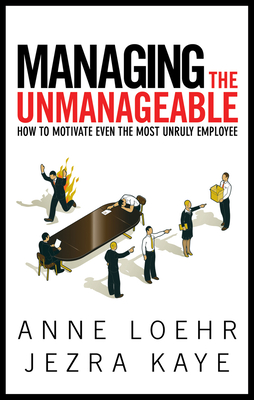It's a different game now. In an increasingly globally diverse workforce, it's vitally important that leaders understand their team inside and out. This takes a new toolbox of skills for the 21st century. Today you need winning strategies to avoid the costly pitfalls of high turnover, low morale and poor collaboration, not to mention the cost of missed deadlines and incomplete projects.
Managing the Unmanageable will give you practical tips and proven techniques to show you how to:
- Understand what's driving your unmanageable employee.
- Evaluate the costs and benefits of turning him around.
- Enroll her in that effort, and help her become a valued member of your team.
- Guide all your employees to greater innovation, cooperation, and effectiveness.
- Communicate effectively with each of the three generations in today's workplace.
I was hoping by reading this book I would gain some insight into the different personalities I now encounter in both co-workers and patrons (because I do consider the patrons when I enroll in any sort of education, as they are ultimately my customers). Even though this book is directed at managers with employee issues, I thought there might be some knowledge to be gained as I looked through the list of "types": the excuse-maker, the grumbler, the egomaniac, the loose cannon, the joker, the slacker, etc. Who hasn't encountered someone that fits into a category like these?
At first the book was very interesting and informative. I was especially struck by one of the worksheets that a manager is supposed to work through before deciding to "commit or quit" on the employee: the "cost" worksheet. It made complete sense to put down how much time the manager has had to spend with the "UE", as the authors refer to the "problem" employees for simplicity's sake, how much time the manager spends soothing other employees who are upset by the UE, etc. But one of the factors is how much it will take to replace said employee, which the authors state should be calculated as 2-2 1/2 times the employee's annual salary. That can be a lot of money! And it explains why companies, at times, push for raises and other compensation to keep employees, rather than let them leave (or help them leave) and start the replacement process. If you have someone working a "menial" low-wage job, this isn't such a concern, as the replacement cost won't be very high. But if you're looking at someone who earns $50,000 or more per year, that can give one a good reason to pause and reconsider giving someone a pink slip.
However, the book became tedious very quickly as the authors worked through the different types of UE's. I understand why they went through each personality in a full chapter, as different people have different hot buttons, needs, currency, etc. But reading through the "5 Cs" each time got rather boring. And I was also put off by the examples as well; they are all in upper-level, office-type settings. Not once was a government job used, or perhaps something in retail (where you can have managers/employees making decent money once they've put in a few years and worked their way up - and where there's a lot of stress). These would all be considered white-collar jobs, and that's being discriminatory in my humble opinion. What about a production line setting? That would have been a great example! Or a construction setting, or anything "blue-collar" - where you can also have grumblers, slackers, egomaniacs, etc.
In the end, I didn't get as much out of this as I had been hoping. It's not a bad book, but it's geared towards a much smaller niche than I would have liked. I found myself skimming through a lot of the last chapters. What I take away from this is don't let small things fester, communicate by asking "open" questions, and be prepared to work if you want to "salvage your UE". And perhaps that's the best thing to remember: these are people we're talking about, not "UEs", and we should discuss them as such.

No comments:
Post a Comment